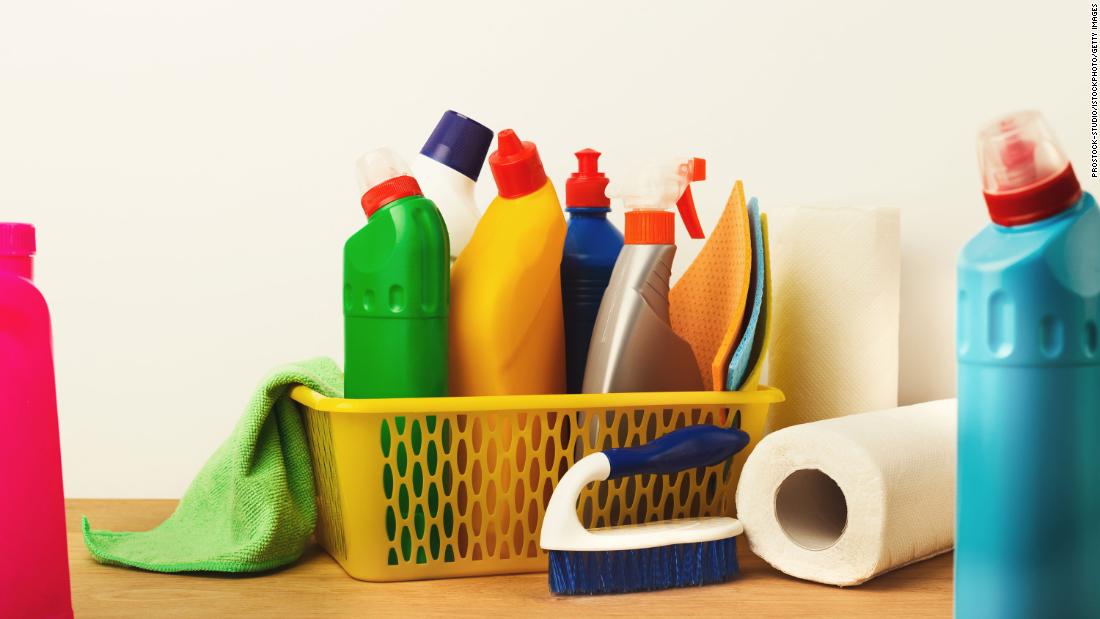
Over 5,000 tons of dangerous fumes escaped from consumer products, study finds

CNN —
Volatile organic compounds, or VOCs, are liquids or solids used in consumer products that turn into gas when exposed to air and sunlight. Some VOCs have been linked to asthma, cancer and reproductive and developmental harm as well as damage to the liver, kidneys or central nervous system.
Shampoo, body lotion, dishwashing soap, caulking compounds, room deodorizers, household cleaners, paint removers, flooring, carpet and pressed-wood products are just a few of the thousands of consumer items that may contain these chemicals.
Exposure is often higher in the home, according to the US Environmental Protection Agency. In fact, “concentrations of many VOCs are consistently higher indoors (up to ten times higher) than outdoors,” the EPA notes.
A study released Tuesday found that over 5,000 tons of 33 potentially harmful VOCs were emitted in 2020 in the state of California, which measures exposures to potential carcinogens and tracks volatile organic compounds in consumer products.
“Picture an ounce of water that evaporates. Even though it is now a gas, the weight doesn’t go away,” said lead study author Dr. Meg Schwarzman, associate director of the Berkeley Center for Green Chemistry at the UC Berkeley School of Public Health.
“We added up the liquid or solid weight of 33 volatile organic compounds in consumer products and found a total of 5,000 tons of volatile gases were released in 2020 alone,” she said. “That’s tons, not pounds – tons.”
Although the analysis was done on products sold in California, the same products are sold across the United States and possibly internationally, Schwarzman noted.
“It’s a wakeup call. So much of the regulatory focus has only been on occupational exposures without thinking about what happens in the home. People don’t understand how much they’re exposed to toxic chemicals in their living environment,” said toxicologist Linda Birnbaum, former director of the National Toxicology Program and National Institute for Environmental Health Sciences, who was not involved in the new paper.
Exposure could raise the risk of a number of health problems, depending on the chemicals, said Jane Houlihan, national director of science and health for Healthy Babies Bright Futures, a coalition of advocates working to reduce babies’ exposures to neurotoxic chemicals, “including low birth weight, birth defects of the male reproductive system and cancer.”
“The breach in our public health regulations that allows toxic VOC chemicals to be used in everyday consumer products is especially dangerous for pregnant women, infants and young children, who are uniquely vulnerable,” said Houlihan, who was not involved in the study.
The Consumer Brands Association, which represents makers of many personal care, household and pet products, among others, did not have a comment on the study.
Telly Lovelace, director of issue communications for the American Chemistry Council, which represents the US chemical, plastics and chlorine industries, told CNN via email that its members are “serious” about their responsibility to produce chemicals that can be used safely.
“Our members undertake extensive scientific analyses to evaluate potential risk of their chemicals, from development through use and safe disposal,” Lovelace added.
The analysis, published in the journal Environmental Science & Technology, used data from the California Air Resources Board, or CARB, which tracks the type and amount of volatile organic compounds used by manufacturers in products sold in California.
“CARB does that because it’s their job to control ground-level ozone, which contributes to smog,” said Homer Swei, senior vice president of healthy living science at the Environmental Working Group (EWG), a nonprofit environmental health organization. Neither Swei nor EWG was part of the new research.
“The reporting by manufacturers is mandatory, and it’s a source of data that doesn’t exist anywhere else,” Swei said. “That database hasn’t been plumbed for this kind of information before, which is quite clever.”
The research team then turned to California’s right-to-know law – the Safe Drinking Water and Toxic Enforcement Act, commonly known as Prop 65 – which maintains a list of chemicals believed to cause cancer or reproductive and developmental harms. Of those, 33 were listed as volatile organic compounds. (Because Prop 65 does not monitor asthma, the effects of VOCs on that condition could not be examined.)
The analysis found that more than 100 types of products contain VOCs flagged by the Prop 65 database. In addition to personal care products, potentially toxic VOCs are used to make insect repellents, disinfectants, laundry detergents, auto and boat care items, carpet and upholstery cleaners, shoe and leather cleaners, and office and art supplies, to name a few.
Consumers can’t easily find that information on a label, unless it involves one of the 33 chemicals of concern under Prop 65, Schwarzman said.
“You’ve seen label warnings that say, ‘This product contains a chemical known to the state of California to cause cancer or reproductive harm,’ or whatever the concern,” she said. “That benefits the rest of the country, because manufacturers don’t create a special label for products sold in California.”
The overall lack of safety information can make it equally hard for companies that want to reformulate their products with nontoxic chemicals, Schwarzman added.
“There’s no centralized list of safer alternatives, so companies that want to reformulate really have to work to find the data,” she said. “It’s also very hard to make claims about safety without implicating your previous version of a product.
“I can’t imagine a label saying: ‘New non-carcinogenic formula’ is now available.”
Researchers placed 11 of the Prop 65-listed chemicals into a top tier of concern, based on their widespread use in consumer and occupational products and their health risk to consumers, workers or the general population.
Mothballs, for example, are made of 1,4-dichlorobenzene, which can break down into such toxic vapors as hydrochloric acid and carbon monoxide, according to the National Center for Biotechnology Medicine.
Of the 5,000 tons of VOCs released in 2020, the study found, mothballs accounted for 300 tons.
Methylene chloride can harm the eyes, liver, heart and skin and may cause cancer, according to the US Centers for Disease Protection and Control.
“Exposure can cause drowsiness, dizziness, numbness and tingling limbs, and nausea,” the CDC says. “Severe exposure can cause loss of consciousness and death.”
About 2.75 tons per day of methylene chloride were emitted in 2020 from consumer products, the study found. Exposure was mostly from paint removers. That was unexpected, Schwarzman said, because of an EPA ban on the use of the chemical in paint strippers in 2019: “We expected that methylene chloride emissions from this source would have declined over time.”
Formaldehyde was the most common VOC product used on the body, appearing in nail polish, shampoo, makeup and other personal care products. Formaldehyde is a known carcinogen, according to the US National Toxicology Program and the International Agency for Research on Cancer. In total, formaldehyde appeared in 17 product categories, including household and industrial cleaners, carpet and pressed wood furniture.
In the home, art supplies, general purpose cleaners and laundry detergents contained the highest number of VOCs, the study found. Just one product, adhesives, exposed users to nearly half of the chemicals of concern.
“As a category, adhesives was the top example of how you can use just one product and get multiple exposures,” Schwarzman said. “There were 17 different Prop 65 potentially toxic volatile organic compounds in adhesives.”
Benzene was the third most common VOC found in consumer products, according to the study. Benzene is a known cancer-causing chemical used to make plastics, dyes, detergents, drugs and pesticides, among other products.
In 2021, a study found benzene in over half of 108 batches of antiperspirant and deodorant body sprays from 30 brands. The discovery prompted manufacturer Procter & Gamble to pull 17 types of Old Spice and Secret antiperspirant off the shelves at the time “in an abundance of caution.”
Finding alternatives is a key way to avoid potentially toxic fumes, experts say. The ongoing consumer interest in green products has provided a number of safer choices, Swei said.
“General-purpose cleaners and personal care products are two of the area where there are significantly safer substitutes, I think,” he said. “I also wouldn’t be too concerned if you use one or two cleaning products every now and then.
“But if your work requires you to use a ton of cleaning products, or too many of the VOC categories all at the same time for long periods of time, that would be a concern,” Swei said.
An ultimate solution would need consumers to speak to lawmakers and manufacturers about the lack of regulations, said former National Toxicology Program Director Birnbaum.
“We don’t regulate indoor air, except radon. We regulate ambient or outdoor air, yet many people spend 90% of their time indoors, especially babies, children and the elderly,” she said.
“We need adequate labeling,” Birnbaum said. “But even then, they may say the chemical is ‘inert’ and not mention that it might become vaporous. We need policy changes at a federal level so choices by individual consumers to protect themselves and their families can be effective.”
Source: https://www.cnn.com/2023/05/02/health/voc-levels-consumer-products-wellness/index.html

















